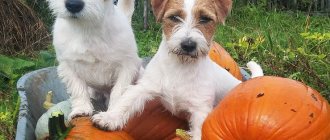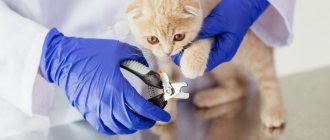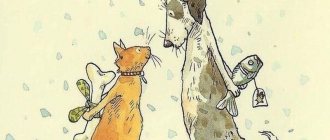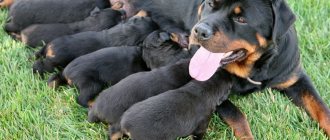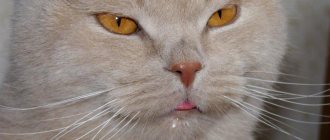The popular image of a dog gnawing on a bone is firmly ingrained in most people's heads. How can a fragile bone harm a domesticated predator, especially a bird’s bone. Indeed, in the wild, dogs’ closest relatives – wolves – eat their prey whole, with entrails and bones.
As a result, out of ignorance or as a result of an irresponsible attitude, inexperienced and careless owners, having fed their pet with bones left over from a family dinner, are faced with serious negative consequences for the pet’s health.
Can I give it to a dog?
It is difficult to answer this question unequivocally. Most veterinarians are inclined to believe that this food should not be given to dogs. But there are other points of view.
It is worth understanding the reasons for the ban and options for including bones in the diet.
What kind of chicken bones can you give?
Permitted types:
Chicken necks. They contain a lot of useful substances. They are given to animals whole, but not more than twice a week. There are no dangerous small bones in the necks, so they can be included in the diet of dogs of large and small breeds.- Heads. You just need to remove the beak, because if the dog swallows this part, it can injure the esophagus. Such by-products will be of particular benefit to racing breeds, because... saturate the pet’s body with essential nutrients.
- Cartilage. No harm is caused. They are considered absolutely safe for pets.
What is the danger for dogs
When chewed, tubular bones break and turn into sharp fragments. When they enter the gastrointestinal tract, they damage the mucous membrane of the digestive organs. This negatively affects the condition of the animal.
Bones contain dangerous bacteria. When exposed to an acidic environment, they begin to actively multiply and cause poisoning.
Which chicken bones are prohibited from being added to food?
Tubular bones from the wings and thighs of a bird can cause serious harm to an adult dog and a small puppy. Feeding them to your pet is strictly prohibited. You should also not give your animal chicken feet. The consequences of their use can be disastrous.
Can it be given to puppies?
Bones are especially harmful to puppies. Their mucous membranes are still very delicate, so the gastrointestinal tract is easy to damage. Hard bones damage tooth enamel when chewed and lead to the formation of an incorrect bite.
Puppies can only be fed chicken necks and heads. They are introduced into the diet no earlier than at four months, given once a week. More frequent consumption of offal can negatively affect the condition of the puppy.
Why can't dogs eat chicken bones?
Tubular bones, especially chicken bones, are dangerous for the digestive system of dogs . The animal's gastric juice does not actually break down bone tissue. As a result, parts of the swallowed bone enter the pet's intestines almost unchanged.
At the same time, thanks to the full zones, tubular chicken bones are light and fragile, especially in birds raised in industrial poultry farms. When chewing, the animal's jaws are easily crushed into small and large fragments with sharp edges, which can subsequently cause indigestion or even severe damage and perforation of the esophagus, stomach and intestines.
In what form can it be given?
It is not enough just to choose bones that are safe for your pet. You need to know in what form they can be used for feeding.
Are boiled bones allowed?
Boiled chicken bones are not digested in the stomach and cause constipation.
During heat treatment, all beneficial substances are destroyed. Boiled bones do not contain anything nutritious in their composition. They settle in the intestines and gradually accumulate, which leads to a deterioration in the dog’s condition.
Is it possible to give raw
The best option would be raw heads or necks.
To destroy pathogenic microorganisms, it is recommended to pour boiling water over offal. This way you can protect your pet from infection.
Bone minced chicken
It is prepared by chopping boiled bones and adding poultry meat. The finished product can be given to animals in small portions maximum three times a week. Its more frequent use leads to the accumulation of meat and bone mass residues in the intestines.
This food is often mixed with porridge and chopped vegetables. As a result, intestinal peristalsis improves, and undigested particles of minced meat are quickly eliminated from the animal’s body.
Is it possible to give your dog chicken wings?
It is highly undesirable to give your dog chicken wings, especially those with bones. The skeleton of the chicken shoulder girdle, like the drumstick, consists of tubular bones, which, among other things, contain a small amount of brain matter and connective tissue, and also have cavities filled with air.
Due to their physiological characteristics, the wing bones are considered the most dangerous for dogs, along with the hip bones..
When chewed, the bones split lengthwise. The resulting sharp, needle-like fragments easily pierce the mucous membrane, getting stuck in the walls of the esophagus and intestines, and as a result cause severe internal bleeding in the animal with the development of complications.
Among other things, chicken wings have a low content of pure protein and a large proportion of animal fat, which is difficult for dogs to digest and increases the load on the liver, which can ultimately lead to its inflammation, and also provokes obesity, primarily in the pet’s internal vital organs.
Therefore, using chicken wings as a crispy treat is not recommended. It is preferable to replace them with frozen chicken necks, heads or paws. These by-products safely clean teeth, massage gums, and are rich in minerals and vitamins. Such treats are especially useful for puppies during the period of teeth change.
READ ALSO: Is it possible to give chicken necks and heads to your dog?
Consequences of use
Eating tubular bones can lead to serious consequences.
Among them are:
Damage to the oral mucosa. As a result of the injuries received, stomatitis and periodontal disease develop.- Chips of tooth enamel, grinding of teeth. Such damage provokes the appearance of pulpitis and caries.
- Sticking of bone particles in the esophagus. Threats of suffocation.
- Damage to the pharynx, trachea. The animal suffers from acute pain.
- Perforation of the digestive organs. When such problems occur, internal bleeding occurs. It is possible that feces and stomach contents may leak into the peritoneal cavity. The animal needs surgery. There is a risk of developing sepsis and peritonitis. The dog may die.
- Sticking of bone particles in the anus, colon. In the best case scenario, constipation will occur. In the worst case, intoxication occurs due to intestinal obstruction.
If your pet has eaten such food, its condition should be monitored for 2-3 days. The following changes should cause alarm:
- loss of appetite or complete refusal to eat;
- clearly expressed anxiety;
lethargy, passivity;- appearance of cough;
- excessive drooling;
- gagging;
- whining;
- the presence of blood in the stool;
- bleeding;
- constipation.
Any of these symptoms should be a reason to contact your veterinarian.
If the incident of bone consumption was isolated, the pet’s condition has not worsened, there is no cause for concern. The pieces pass out on their own in the feces.
Sometimes your pet needs help to cleanse its intestines to avoid negative consequences . A wax candle (a small piece) that needs to be fed to the animal will help with this.
When it enters the gastrointestinal tract, it begins to melt, envelops sharp particles and promotes their safe removal from the body.
For a small breed dog, three centimeters of a church candle will be enough. Large dogs need to be fed about half.
An hour and a half after this procedure, the pet is given its usual food. It is noted that the risk of damage to the mucous membranes is significantly higher if the stomach is empty.
You should give your dog a candle three times a day. You need to use only natural products. Paraffin is absolutely useless.
It is strictly forbidden to induce vomiting or use laxatives. When performing such actions, the walls of the gastrointestinal tract begin to contract, and sharp bone particles can dig into them.
How to keep your dog safe
In order for a dog to live a long time, it is necessary to reduce the risk of ingesting foreign objects. For this it is recommended:
- purchase items for play according to the size of the pet;
- When walking, wear a muzzle to prevent the dog from picking up prohibited objects;
- Give the dog only soft bones.
Neglected situations are difficult to treat.
Ways to prevent the problem
Are bones good for dogs?
This food is only useful if used correctly.
Why you should give:
- Tendon ligaments and muscles. This is necessary for training the animal’s chewing apparatus (offer it to your pet once every 1–1.5 weeks).
- Cartilaginous tissues have a hard surface and help clean tooth enamel from plaque and deposits containing pathogenic microorganisms.
- The bones contain bone marrow inside. It is rich in animal proteins and is a valuable nutritional supplement. Thanks to its consumption, the pet’s body is saturated with a whole complex of fatty amino acids.
Bones contain useful microelements (magnesium, calcium, phosphorus) necessary for proper nutrition of the pet.- Monotonous chewing and gnawing gives the dog the opportunity to occupy himself, calm down, take a break from one activity and switch to another.
- Safety of furniture and shoes. By chewing bones, the dog will not encroach on things in the house.
The dog swallowed chicken bones
Chicken bones for dogs can only be used from broiler chickens. Birds raised in poultry farms have weak bones that do not form sharp edges when bitten. However, if your dog has eaten a chicken bone from domestic chickens, you need to know what to do in such cases. Village birds have a strong skeletal system, so it can damage the intestines and lead to the death of the animal.
Damage to bones for dogs
Veterinarian advice
Experts have differing opinions regarding the introduction of offal into the diet of pets. Some veterinarians are categorically against including heads and necks in the dog’s menu, others allow this feeding option.
Things to remember:
- Give by-products exclusively in raw form. In this case, the body receives maximum nutrients.
- Observe the body's reaction after feeding: diarrhea, constipation, deterioration of the skin indicate that such food is not suitable for the dog.
Give offal to your pet 1-2 times a week, combining them with their usual food.- When switching to natural food, you need to give the animal time to get used to it. After dry food, side effects (vomiting, diarrhea) are possible.
- Carefully monitor what your pet eats.
- Give necks and heads when the pet is full. In this case, he will not chew them completely.
- Buy by-products from trusted places. It is prohibited to buy from hand at spontaneous markets, where the goods are often in unsanitary conditions and are not the freshest.
- If any negative manifestations occur, you should seek help from a veterinary clinic..
Actions if your pet is choking
If a dog swallows a bone whole, you need to know what to do.
Puppies and small breeds
Bones for small breeds can be very dangerous. Puppies need to be especially closely monitored. You need to know what to do if your puppy eats a bone and problems arise. The algorithm of actions should be as follows:
- open the mouth and carefully examine the throat with a flashlight;
- Make sure the dog can breathe normally. Very often the bones block the airways;
- holding the animal by the hind legs, lift it slightly;
- If there are symptoms of suffocation, the puppy should be pressed to the knees and with sharp movements of the palm, press the diaphragm.
If nothing can be done, you must urgently go to a veterinary hospital for help.
Important! When assisting puppies and small breeds, it is necessary to take into account the fragile constitution of the animal's body. Too sudden and strong pressure can lead to a spinal fracture.
Large pets
You can help a large pet by pressing against the animal’s back and placing your palm below the chest and applying sharp compressions. The procedure is carried out until the pet spits out the foreign object.
Helping a large dog
If there are no symptoms of suffocation, you can pour 50 grams of sunflower oil into the dog’s mouth. It will facilitate the rapid passage of bones through the digestive organs.
Veterinarian recommendations
If your dog has swallowed bones, you must follow the following recommendations from your veterinarian:
- Cut the church candle into small pieces. Remove the wick and give to the dog in small portions. The wax will envelop the bone and gently remove it naturally;
- monitor the dog's well-being. If unpleasant symptoms do not go away within 24 hours, you should visit a specialist.
The dog requires careful care. Even if complications do not appear within several days, it is necessary to closely monitor the animal’s well-being in order to avoid possible infectious diseases.
Expert advice
You need to know what to do if your dog ate a chicken bone. Bones can lead to the death of a pet or damage to the digestive organs in a short time. If the animal is choking and refuses food, it is recommended to consult a specialist and not self-medicate.
